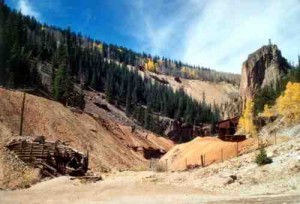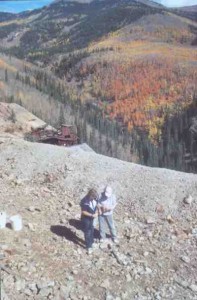Essay by Patty Lataille
Recreation – July 2006 – Colorado Central Magazine
I’M A LITTLE TIRED of being quiet — particularly in regard to my need for silence and tranquility when I’m in the woods. I go to the forest and hike in the mountains when I’m seeking the silence and solace of nature. It calms me. Soothes my jangled nerves. Keeps me sane. It’s why I came to live in Colorado in the first place. New York City/Long Island was just a little too busy. It was too crowded with people and full of non-stop noise. I head for the hills when I need to get away — even from the rural life here in the San Luis Valley. Face it, I didn’t move to a town of 80 people to become a socialite.
My hikes bestow me with a sense of peace — and hope for the future of this earth, along with the species which inhabit it. Except ours. Especially when I see some yahoo revving his or her ATV motor, all ready to tear up the land on a designated non-motorized trail — a trail specifically set apart from the multitude of others that permit mechanized recreation.
When I see this sorry sight, I don’t feel very peaceful — interruptive motor noise annoys me. It detracts from my experience in using our public lands. It’s inconsiderate. I want to tell these motorheads to go find their own place to play — where their noise and rough roading are welcome. There’s a time and a place for everything. But it’s not everywhere. Your rights as a motorized recreationist should not trample my right to quiet recreation. Have your fun elsewhere. Show a little respect to the quiet crowd.
Quiet is My Right — I Need a QUA!!
A QUA (Quiet Use Area) is an area of significant size, (not just a trail), set aside for a wide variety of quiet traditional recreational uses on our public lands. Picture, if you will — areas in our national forests and Bureau of Land Management (BLM) lands designated for “Quiet Use.” Quiet — meaning without excessive user noise — to ensure the experience of a natural soundscape. Think hiking, trail running, mountain biking, Nordic skiing or snowshoeing in an area free of motorized vehicles. Recreationists, hikers, campers, families, etc., can enjoy their outdoor experience unconcerned with the whine of motors, or facing a motorcyclist head on at a tight switchback. There would be no fear of canine companions run over by four-wheelers, no loud engines racing as an assault on the ears, no noxious exhaust fumes polluting their respiratory tracts — just silence, serenity and a peace of mind that stays intact.
The Antonym to Quiet is Noise.
Personal Motorized Recreational Vehicles (PMRVs) — i.e., dirt bikes, snowmobiles, ATVs, jet skis or similar vehicles — would not be permitted in a QUA. Why not? Because as the owners, operators and individuals recreating on our public lands and waterways can attest to: machines make noise. Intrusive noise. Motorized sounds can carry for miles.
Multiple Use — Shared Use Areas — no Longer an Option.
From the standpoint of noise intrusion, the multiple use — or shared use — concept of land use is a farce. Motorized noise intrudes on all other activities — it has long-ranging capabilities to nullify the natural sounds and degrade a traditional recreational user’s experience.
Quiet users and motorized recreationists have been compared to “smokers versus non-smokers.” Each is unable to co-exist peacefully with the other — separate areas and restrictions had to be constructed for a peaceable existence in the smoking situation — why not in the recreational arena?
Massive growth in the PMRV industry is negatively impacting our dwindling public landscape and soundscape. The Quiet Use Coalition (QUC), quietuse.org a conservation-based organization which supports preserving and promoting traditional use and enjoyment of quiet areas on our public lands and waters, is concerned that unregulated motorized use on public lands will continue to degrade the outdoor experiences that are a vital part of many lives here in Colorado and elsewhere.
The QUC foresaw the growth of motorized recreation and the ensuing conflict of interest between PMRV and traditional users coming years ago. Public land agencies have been painfully slow to address these issues. The QUC has been working to restore balance to our public lands and waters by promoting the concept of Quiet Use Areas.
Questions arise concerning the criteria for designation of a QUA. While a Wilderness Area would be the ultimate in quiet use, a broader perspective of recreation needs and uses had to be addressed. The difference between a Wilderness area and a QUA is that the establishment of a QUA would not require the more rigid pristine land attributes necessary under the Wilderness Act. QUAs are for walking, hiking, biking, hunting, fishing, horseback riding, climbing, wild life viewing, canoeing, backpacking, nature photography, etc. They would be off limits to PMRVs, but QUAs would be more accessible than wilderness areas — because one could drive a 4-wheel highway licensed vehicle (be it a car, truck or SUV) into a QUA to access trailheads and points of interest.
The Forest Service and the Bureau of Land Management are well aware of conflicts between motorized and non-motorized users and have been contacted by many individuals who comprise the “Quiet Use Movement.” This movement is gaining support and national exposure as concerned citizens organize to send a message to our legislators and public land managers that they will take action to prevent assault by noise, pollution and environmental devastation, while recreating in our national forests and public lands and waterways.
Fortunately, there is a middle-ground that can be reached between motorized and non-motorized recreational users of public lands. Separate use areas are only one answer. Another way to mitigate potential user conflict is be involved in your local Travel Management Planning process with the BLM and Forest Service officials. Personal user input provides vital insight for the land use managers to consider in trail designation and whether a trail stays open or closed to motorized vehicles.
For years, conservationist groups, including the Quiet Use Coalition, have identified the unmanaged use of dirt bikes, ATVs and other off-road vehicles as one of the greatest dangers to the integrity of America’s public lands. As the noise and resource damage have grown, organizations have urged the Forest Service and other public land management agencies to impose sensible controls on dirt bikes and four-wheelers.
Initially it appeared that these requests were ignored. Now, Forest Service Chief Dale Bosworth has identified unmanaged recreation, particularly off-road vehicle use, as one of the four great threats to our National Forests. In this assessment, Chief Bosworth joins his predecessor Mike Dombeck, who singled out ATVs as among the major threats to America’s forests and other public lands many years ago. The National Forest Service is currently in the process of rewriting regulations governing the use of dirt bikes, ATVs and other off-road vehicles on National Forests and Grasslands. Community Town Hall meetings are taking place across the United States as land use managers update their Travel Management Plans.
Meanwhile, local grassroots groups are joining with state and national conservationist organizations, such as the QUC with The Colorado Mountain Club, The Southern Rockies Conservations Alliance (SRCA) and The Wilderness Society to further the Quiet Use movement. Non-traditional allies such as long-time ranchers and bow-hunters have swelled the ranks, and two landmark conferences have been held to address Quiet Use issues. In February 2005, the Quiet Use Coalition, the Colorado Mountain Club and the Southern Rockies Conservation Alliance sponsored a weekend conference at the Monarch Mountain Lodge in Chaffee County. Fifty-seven conservationists representing twenty-five organizations and concerned citizens from across the Rocky Mountain region joined forces in this forum to discuss ways to protect and preserve quiet recreation on our public lands.
More recently, the Quiet Commotion was held in Crestone. More than seventy quiet use supporters participated in the two-day discussion. Their brainstorming and strategy planning culminated in a Quiet Use and Responsible Motorized Recreation campaign. A national steering committee was formed and the drive for specific quiet use areas continues.
As for my recent experiences in the woods lately? Besides collecting tossed beer bottles and obliterating illegal campfire rings at a nearby trailhead, I’ve treaded lightly enough to catch a red-tailed hawk circle in mid-flight, watch a burnished red-brown coyote sprint through the (unfortunately) brown, beige and dusty plains, and also rounded a bend by a creek and surprised a medium-sized black bear in the wild. The deer and the antelope really are out playing here in the Valley. But that will only continue if the visiting dirt bikers don’t continue to chase and scatter the herds for fun, as I witnessed on a recent hike near Hayden Pass. Rest assured that the Division of Wildlife toll free Hotline number (1 800 332-4155) was called and the wildlife harassment incident was reported.
Try to be the “Eyes of the Forest” — help keep our lands quiet and the wild creatures safe — and free of motorized intrusion.
###
Silence is Significant
Patty LaTaille lives and writes in the greater Villa Grove area.


